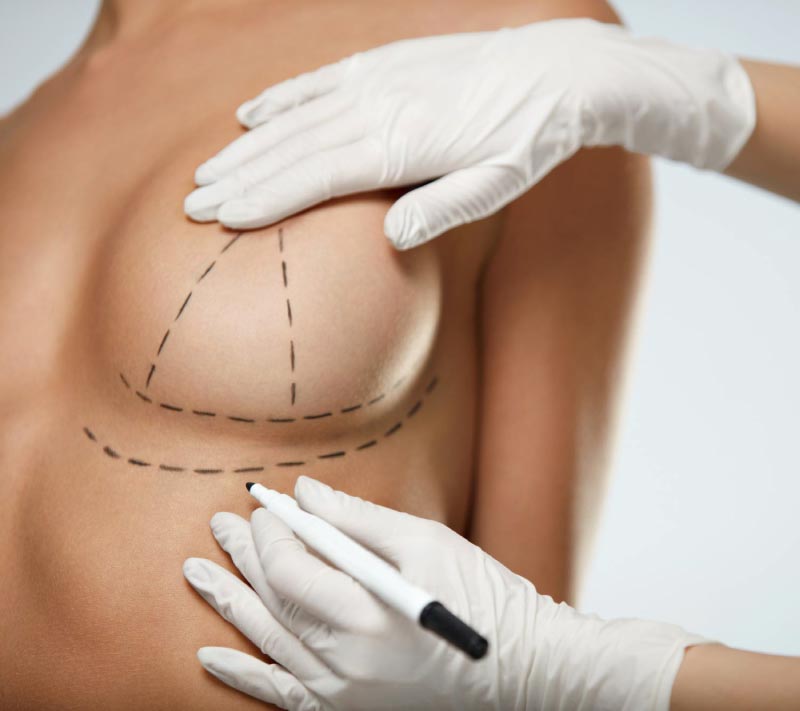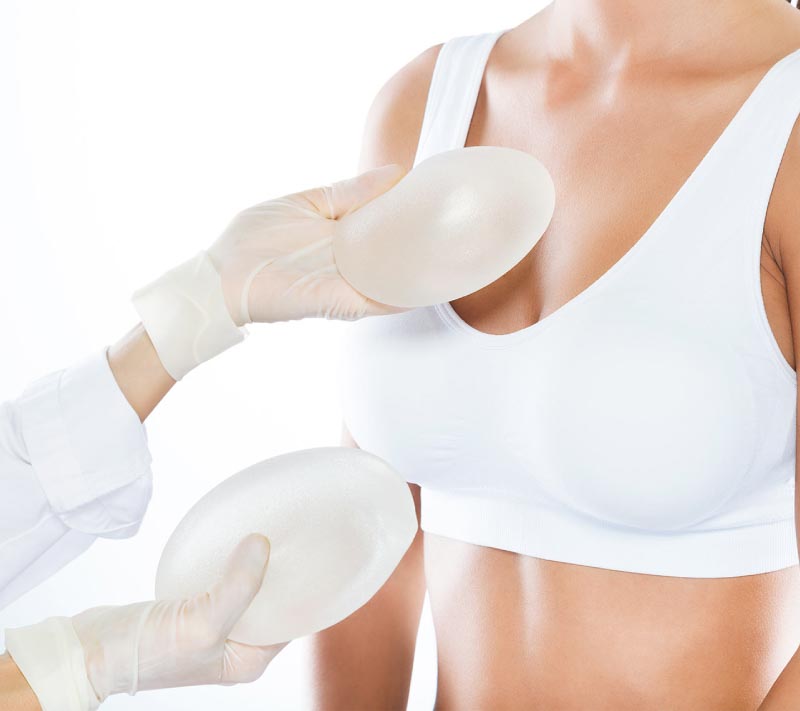
Breast Lift with Augmentation
A Breast lift and Breast Augmentation procedure can be combined to lift and enhance the breast with more volume at the same time. The mastopexy augmentation procedure allows the implant to be placed at the time of the mastopexy to make the breasts appear larger and firmer, while rearranging the breast skin and decreasing the areola size to give the breasts a more youthful appearance.
What Is A Breast Lift with Augmentation?
A breast lift (mastopexy) is a procedure used to lift sagging breasts, while an augmentation mammoplasty is a procedure performed to increase the size of a woman’s breasts using an implantable prosthesis. These two procedures can be combined to lift and enhance the breast with more volume.
The mastopexy augmentation procedure allows the implant to be placed at the time of the mastopexy to make the breasts appear larger and firmer, while rearranging the breast skin and decreasing the areola size to give the breasts a more youthful appearance.
This technique is often used after women have lost weight or after breastfeeding when the volume of breast tissue has decreased and the size of the pigmented area around the nipple (the areola) enlarges.
It is important to note that while an implant traditionally makes the breast larger, it can also be used to restore volume in deflated breasts. It is not necessary to make a woman’s breasts larger than they already are. In fact, in some circumstances, Dr. Parson can keep your cup size the same by removing some of your own breast tissue during the lift and replacing it with an implant. Breasts that are large and heavy can be lifted, but the results may not be as long-lasting as when the procedure is done on smaller breasts.

Incision Location
There are a few standard ways of lifting a woman’s breast: Peri-areolar Mastopexy, Vertical Mastopexy, and Standard Mastopexy. The factors that determine which way that is most suited to your specific anatomy include: the size and shape of your breasts, the size of your areolas, and the extent of breast ptosis (breast droop). All of these factors will be taken into consideration and will help Dr. Parson determine the best technique for you and your body.
Peri-areolar Breast Lift
Peri-areolar Mastopexy involves a circular incision made around the areola and is reserved for women who have a small amount of sagging. If there is a moderate amount of sagging, a second incision which runs vertically from the bottom edge of the areola to the crease underneath the breast, similar to a lollipop, may be needed.
Standard Breast Lift
After Dr. Parson removes excess breast skin, the nipple and areola are shifted to a higher position. The areola, which in a sagging breast may have been stretched, can be reduced in size. Skin that was formerly located above the areola is brought down and sutured together beneath it to reshape the breast. The nipples and areolas remain attached to underlying mounds of tissue, and this usually allows for the preservation of sensation and the ability to breast-feed.
Incision Location

There are a few standard ways of lifting a woman’s breast: Peri-areolar Mastopexy, Vertical Mastopexy, and Standard Mastopexy. The factors that determine which way that is most suited to your specific anatomy include: the size and shape of your breasts, the size of your areolas, and the extent of breast ptosis (breast droop). All of these factors will be taken into consideration and will help Dr. Parson determine the best technique for you and your body.
Peri-areolar Breast Lift (Mastopexy)
Peri-areolar Mastopexy involves a circular incision made around the areola and is reserved for women who have a small amount of sagging. If there is a moderate amount of sagging, a second incision which runs vertically from the bottom edge of the areola to the crease underneath the breast, similar to a lollipop, may be needed.
Standard Breast Lift (Mastopexy)
After Dr. Parson removes excess breast skin, the nipple and areola are shifted to a higher position. The areola, which in a sagging breast may have been stretched, can be reduced in size. Skin that was formerly located above the areola is brought down and sutured together beneath it to reshape the breast. The nipples and areolas remain attached to underlying mounds of tissue, and this usually allows for the preservation of sensation and the ability to breast-feed.
Breast Implant Types
The implant will be placed through one of the incisions made to perform the lift and is usually positioned below the muscle. Determination of whether a silicone (gel) or saline implant is used, as well as the size of the implant will be discussed during your first consultation. Often times, Dr. Parson will ask patients to bring in pictures of their desired size and shape. This helps foster communication between you and Dr. Parson so that we can help you achieve your desired results with reasonable expectations.
Several varieties of implants have been developed for breast augmentation over the last several decades. The type of implants used today in the United States all have a silicone shell. One type is filled with saline, the other with silicone. Saline implants have the advantage of being able to be adjusted intra-operatively because they are implanted as a flat balloon, and then filled up with saline during surgery. These implants may be better suited for patients who have a significant size difference between breasts. The silicone-filled implants have the advantage of a more natural feel and may be better suited for women are thin and do not have a lot of breast tissue.
In addition, both implants come in various forms. The silicone shell may be smooth or textured. Implants also come in two shapes, round or anatomical. The “anatomical” implant has a teardrop shape that theoretically creates a more natural-looking breast. In practice, however, the round and anatomical implant has the same appearance when implanted and the anatomic implant carries the risk of an unnatural feel. Dr. Parson typically uses the round-style implant. Lastly, there are several profiles of implants. Your chest shape, breast size and desired result will help us determine which implant is right for you.

Breast Implant Types

The implant will be placed through one of the incisions made to perform the lift and is usually positioned below the muscle. Determination of whether a silicone (gel) or saline implant is used, as well as the size of the implant will be discussed during your first consultation. Often times, Dr. Parson will ask patients to bring in pictures of their desired size and shape. This helps foster communication between you and Dr. Parson so that we can help you achieve your desired results with reasonable expectations.
Several varieties of implants have been developed for breast augmentation over the last several decades. The type of implants used today in the United States all have a silicone shell. One type is filled with saline, the other with silicone. Saline implants have the advantage of being able to be adjusted intra-operatively because they are implanted as a flat balloon, and then filled up with saline during surgery. These implants may be better suited for patients who have a significant size difference between breasts. The silicone-filled implants have the advantage of a more natural feel and may be better suited for women are thin and do not have a lot of breast tissue.
In addition, both implants come in various forms. The silicone shell may be smooth or textured. Implants also come in two shapes, round or anatomical. The “anatomical” implant has a teardrop shape that theoretically creates a more natural-looking breast. In practice, however, the round and anatomical implant has the same appearance when implanted and the anatomic implant carries the risk of an unnatural feel. Dr. Parson typically uses the round-style implant. Lastly, there are several profiles of implants. Your chest shape, breast size and desired result will help us determine which implant is right for you.
Breast Implant / Lift Galleries
See Before/After Photos*
Over or Under The Muscle?
In addition to several types of incisions and implants, there are also two possible locations for placement of the implant. The implant can be placed beneath the breast tissue, but on top of the pectoralis muscle. The second, more common method is to place the implant beneath the pectoralis muscle, between the pectoralis and the ribs.
Advantages of Above the Muscle
The advantages of placing the implant above the muscle are that it is less painful for the first few days and the appearance of the implanted breast matures faster. In addition, contraction of the pectoralis muscle, more noticeable in body-builders, has no effect on the appearance of the breast.
Advantages of Under The Muscle
The advantages of placing the implant under the muscle are several.
- It provides a more natural appearing breast with a better transition from the upper chest to the breast mound.
- The rates of scarring around the implant are significantly lower when the implant is placed beneath the muscle.
- The risk of visible ripples or folds in the implant envelope (a more common problem with saline than with silicone implants) is diminished because of the greater amount of the patient’s own tissue overlying the prosthesis.
- The ability to obtain an adequate mammogram is enhanced with placement under the muscle, as the mammogram technician is better able to separate the breast from the implant when the muscle is interposed.
Contact Dr. Shaun Parson in Scottsdale
With the exception of patients who are bodybuilders, Dr. Parson usually recommends the sub-pectoral technique to his patients. Every plastic surgeon has their preference for incision and each approach has its benefits and disadvantages. No one way is correct all of the time. Dr. Parson varies his choice of incision depending on the specific characteristics of the individual.
Breast lift surgery is a comprehensive procedure that can help women regain the youthful contours they desire. If you are unhappy with the appearance of your breasts and would like to learn more about mastopexy, call Dr. Shaun Parson today at 480-282-8386. During your consultation, he can review your procedure options, including breast lift and breast augmentation.



